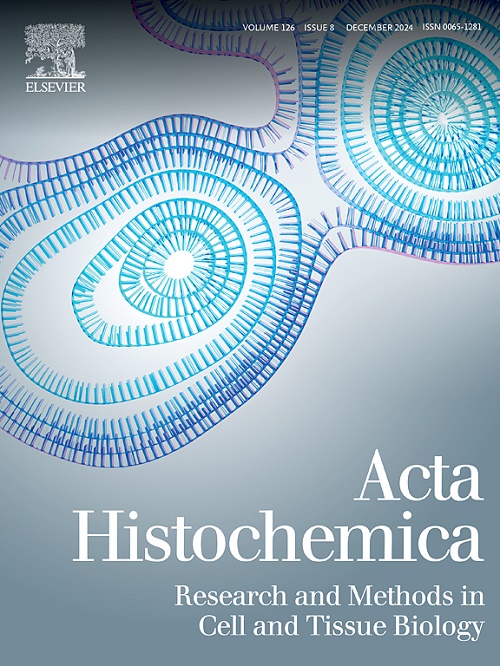癌症相关成纤维细胞衍生的CCL5通过上调IP3R增强有氧糖酵解,促进乳腺癌细胞转移
IF 2.4
4区 生物学
Q4 CELL BIOLOGY
引用次数: 0
摘要
本研究旨在探讨癌症相关成纤维细胞(CAF)衍生的趋化因子C-C基序配体5 (CCL5)是否通过上调IP3R来促进有氧糖酵解,从而促进乳腺癌(BC)细胞转移。方法构建CCL5过表达或低表达的慢病毒载体,转染到CAFs中,与ZR-75-30细胞CCL5共培养。采用CCK-8、克隆实验和流式细胞术检测细胞增殖和凋亡情况。通过划痕实验和Transwell实验验证了细胞的迁移和侵袭。Co-IP验证了CCL5和IP3R之间的相互作用。该试剂盒检测有氧糖酵解相关指标。western blotting检测CCL5、IP3R、糖酵解相关蛋白、emt相关蛋白和转移相关蛋白。结果caf中CCL5的下调和与乳腺癌细胞的共培养导致CCL5细胞增殖、迁移和侵袭减少,凋亡增加,有氧糖酵解减弱。共免疫沉淀(Co-IP)实验揭示了CCL5和IP3RCCL5之间的直接蛋白相互作用。CCL5敲低后IP3R过表达挽救了乳腺癌细胞的增殖活力,恢复了CCL5的迁移和侵袭能力,并增强了有氧糖酵解。结论caf衍生的CCL5通过上调IP3R表达,促进乳腺癌细胞的有氧糖酵解,从而促进乳腺癌细胞的转移。数据可获得性用于支持本研究结果的数据可应要求从通讯作者处获得。本文章由计算机程序翻译,如有差异,请以英文原文为准。
Cancer-associated fibroblast-derived CCL5 enhanced aerobic glycolysis through upregulation of IP3R to promote breast cancer cell metastasis
Background
This study aimed to investigate whether cancer-associated fibroblast (CAF)-derived chemokine C-C motif ligand 5 (CCL5) promotes breast cancer (BC) cell metastasis by enhancing aerobic glycolysis via upregulation of IP3R.
Methods
Lentiviral vectors for CCL5 overexpression or knockdown were constructed, transfected into CAFs, and co-cultured with ZR-75–30 cells CCL5. Cell proliferation and apoptosis were assessed by CCK-8, cloning assay and flow cytometry. Cell migration and invasion were verified by scratch assay and Transwell assay. Co-IP verified the interactions between CCL5 and IP3R. The kit detects aerobic glycolysis-related indexes. western bloting detects CCL5, IP3R, glycolysis-related proteins, EMT-related proteins and metastasis-related proteins.
Results
Knockdown of CCL5 in CAFs and co-culture with breast cancer cells resulted in decreased cell proliferation, migration, and invasionCCL5, increased apoptosis, and attenuated aerobic glycolysis. Co-immunoprecipitation (Co-IP) assays revealed direct protein-protein interactions between CCL5 and IP3RCCL5. IP3R overexpression following CCL5 knockdown rescued breast cancer cell proliferative viability CCL5, restoration of migration and invasion abilities, and enhanced aerobic glycolysis.
Conclusion
CAF-derived CCL5 enhanced aerobic glycolysis in breast cancer cells by up-regulating IP3R expression, which in turn promoted their metastasis.
Data Availability
The data used to support the findings of this study are available from the corresponding author upon request.
求助全文
通过发布文献求助,成功后即可免费获取论文全文。
去求助
来源期刊

Acta histochemica
生物-细胞生物学
CiteScore
4.60
自引率
4.00%
发文量
107
审稿时长
23 days
期刊介绍:
Acta histochemica, a journal of structural biochemistry of cells and tissues, publishes original research articles, short communications, reviews, letters to the editor, meeting reports and abstracts of meetings. The aim of the journal is to provide a forum for the cytochemical and histochemical research community in the life sciences, including cell biology, biotechnology, neurobiology, immunobiology, pathology, pharmacology, botany, zoology and environmental and toxicological research. The journal focuses on new developments in cytochemistry and histochemistry and their applications. Manuscripts reporting on studies of living cells and tissues are particularly welcome. Understanding the complexity of cells and tissues, i.e. their biocomplexity and biodiversity, is a major goal of the journal and reports on this topic are especially encouraged. Original research articles, short communications and reviews that report on new developments in cytochemistry and histochemistry are welcomed, especially when molecular biology is combined with the use of advanced microscopical techniques including image analysis and cytometry. Letters to the editor should comment or interpret previously published articles in the journal to trigger scientific discussions. Meeting reports are considered to be very important publications in the journal because they are excellent opportunities to present state-of-the-art overviews of fields in research where the developments are fast and hard to follow. Authors of meeting reports should consult the editors before writing a report. The editorial policy of the editors and the editorial board is rapid publication. Once a manuscript is received by one of the editors, an editorial decision about acceptance, revision or rejection will be taken within a month. It is the aim of the publishers to have a manuscript published within three months after the manuscript has been accepted
 求助内容:
求助内容: 应助结果提醒方式:
应助结果提醒方式:


